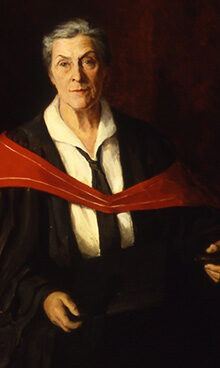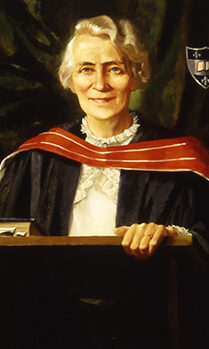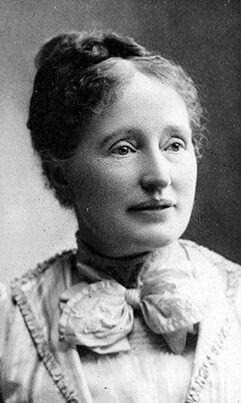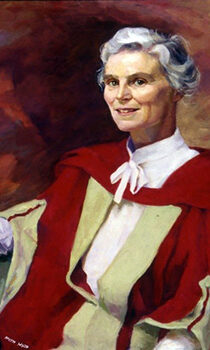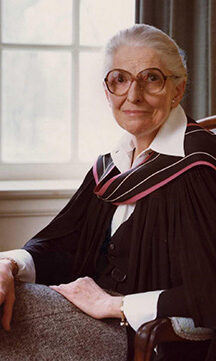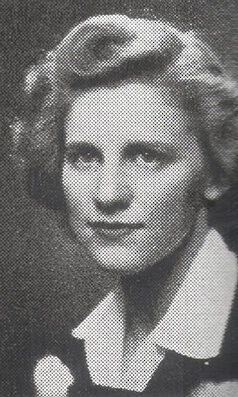Celebrating Leaders of St. Hilda’s College
Who are the people behind the named rooms at St. Hilda’s College?
They are inspiring and compassionate women, accomplished scholars and influential leaders. Admired and revered by the Trinity community and beyond, their many contributions have helped to shape who we are as a community today.
On International Women’s Day 2019 (March 8), we look back at some of the incredible women of St. Hilda’s College who left a special mark within the historic spaces of the college.
THE ABBOTT ROOM:
Elizabeth Abbott, MA, PhD (1942-) – Second Dean of St. Hilda’s College and Sixth Dean of Women Students at Trinity College, 1991-2004
In 1991, Abbott was installed as Trinity College’s Dean of Women and Dean of St. Hilda’s College, where she served for thirteen years until retiring in 2004 to become a full-time writer. During her deanship, Abbott, an advocate for social justice, was Trinity’s representative on the University of Toronto’s Committee on Homophobia, on the Editorial Board of the Canadian Human Rights Foundation, and on the Rights and Freedoms Committee of the Writers’ Union of Canada. She also served as an adviser to Trinity’s Latin American Club and, from 1992 to 1997, played defence for the Saints, the Trinity women’s ice hockey team. When Abbott retired, the former Dean’s Reception Room in St. Hilda’s was renamed The Abbott Room in her honour. In October 2017, the student wellness space opened in the Abbott Room with the room’s namesake Elizabeth Abbott in attendance at the welcome event.
CARTWRIGHT HALL:
Mabel Cartwright, BA, LLD (1869-1955) – Second Principal of St. Hilda’s College, 1903-1936 and First Dean of Women Students at Trinity College, 1915-1936
In 1903 she was appointed Principal of St. Hilda’s College and in 1915 she was granted the additional title of Dean of Women at Trinity College. Academically, Cartwright was Lecturer in English at Trinity College from 1916 until 1928, when she was promoted to Associate Professor of English. In 1925 she oversaw the move of St. Hilda’s College from Queen Street to three houses on St. George Street. Cartwright was determined to retain the old college traditions, but also continue to foster a strong and long-lasting sense of community and belonging among the Saints. She made sure to involve non-residents in the college’s activities and called for mandatory attendance at chapel and choir as well as active social service work by every student. Also in 1925, she was granted a Doctor of Laws (honoris causa) by the University of Toronto. When Cartwright retired in 1936, she was granted the title of Principal Emeritus. In November 1937 she laid the cornerstone for the new St. Hilda’s College building on Devonshire Place. An inspiring teacher, great scholar, and influential leader, she was much loved by the students of St. Hilda’s.
KIRKWOOD HOUSE and KIRKWOOD MEADOWS:
Mossie May (Waddington) Kirkwood, MA, PhD, DSL (1890-1985) – Third Principal of St. Hilda’s College and Second Dean of Women Students at Trinity College, 1936-1953
An alumna of Trinity College, in 1936, Mossie May (Waddington) Kirkwood returned to Trinity College as Principal of St. Hilda’s and Dean of Women as well as Associate Professor of English. Under her leadership St. Hilda’s moved to its building on Devonshire Place, which opened in 1938. As principal, she was much adored and admired by her students, and her importance to the women cannot be overstated. Her office was always open and she was a sympathetic listener. She was an advocate for women’s education and the right for them to have satisfying lives and careers and gave evening lectures for women interested in continuing their studies. Wishing to expose her students to new experiences, once a week she would organize a dinner where students interacted with important poets, dramatists, academics, and painters (notably the Group of Seven). In 1953, Kirkwood resigned from her administrative duties but remained in the English Department as the first woman to hold a full professorship, and when she retired in 1960 she became the first woman to be named professor emeritus. In September of that year the north wing of St. Hilda’s College was opened and named in her honour, and in 1977 Trinity College bestowed upon her the degree of Doctor of Sacred Letters (honoris causa).
RIGBY ROOM:
Ellen (Patteson) Rigby (1855-1913) – First Principal of St. Hilda’s College, 1888-1903
In 1888, the second Provost of Trinity College, The Rev. Charles W.E. Body, ventured to establish a separate residential college for women to secure for them the same privileges the male students already received. That year, Ellen Patteson was offered the position of principal and in October opened up the first St. Hilda’s building on Euclid Avenue. The appointment of Patteson laid a strong foundation for both St. Hilda’s College and for women’s education in Canada, and in 1894 Trinity College opened all its lectures to women. Although the project was an experimental one, Patteson was able to carry the college from its infancy to a permanently successful and self-supporting college residence. Eventually the original house became too small. In 1889 new houses were found on Shaw Street, and in 1892 the college moved to larger ones on the same street. In 1899 construction began on a new building on the main Trinity College campus on Queen Street. In 1896, Patteson married The Rev. Oswald Rigby, the Dean of Residence at Trinity College. In 1903, The Rev. Rigby was appointed Headmaster of Trinity College School in Port Hope, Ontario. The now Mrs. Rigby accompanied her husband to his new job, bringing her tenure as principal to an end. There, as at St. Hilda’s, Rigby was greatly loved by the students, because of her warmth, sympathy, and concern for their wellbeing.
ROWLINSON HOUSE:
The Rev. Elizabeth Maude (Hunter) Rowlinson, BSc, MA, PhD, DD – First Dean of St. Hilda’s College and Fifth Dean of Women Students at Trinity College, 1978-1991
In 1978, Elizabeth Maude Hunter was appointed Dean of Women at Trinity College and Dean of St. Hilda’s College, as well as a fellow of the college. In terms of teaching, Rowlinson held the position of Senior Tutor in Mathematics at the University of Toronto, and authored a number of articles and reviews in various mathematical journals. In her role as Dean of Women she saw herself as a counsellor for her students. Unlike her predecessors, with the changing times she was no longer acting in loco parentis. However, she was involved in many aspects of student life, attending dinners, holding receptions, playing the violin in the Trinity College Chamber Orchestra, and singing in the Chapel Choir. When Rowlinson first arrived at St. Hilda’s, there were more women than men making up the student body, but less space for them in residence. She oversaw the first instance of women living in the main Trinity building, when, for two years, women moved into The Angel’s Roost as a temporary solution until, in 1981, the south wing of St. Hilda’s College was built. It has borne Rowlinson’s name since 1995. In 1991 Rowlinson retired from Trinity College, and became a Fellow Emerita. She was ordained a deacon in the Anglican Church on 6 June 1993, and on 15 May 1994 she was ordained a priest.
MELINDA SEAMAN HALL:
Melinda Hartnet Seaman, MA (1912-1992) – Fifth Principal of St. Hilda’s College and Fourth Dean of Women Students at Trinity College, 1963-1978
An alumna of Trinity College, in 1963 to become the Principal of St. Hilda’s College and Dean of Women at Trinity College, as well as Assistant Professor of English. She dedicated herself to improving the quality of residence life, from small things such as selecting furniture and paring roommates, to larger endeavours like vocally opposing the gradual shift of student activities to the main Trinity building. St. Hilda’s to her was a community which deserved its own cultural and athletic events, to which the men of Trinity were welcomed. During her time as principal she strove to ensure that non-resident students felt as much at home at St. Hilda’s as the residents did, making an effort to know them as well as she did the women she lived with, and opening up dinners to those who had evening classes. During her tenure, she oversaw the relaxation of institutional restrictions and curfews, the growth of student autonomy, and the move toward joint government and committee decision making between St. Hilda’s and Trinity. She was also the last person to be designated “Principal of St. Hilda’s College”. Like her predecessors, Seaman was a maternal figure for the women of St. Hilda’s, ready to offer advice and encouragement to those who asked for it. Loved by her students, at her retirement party in April 1978 they gave her an academic gown for Nicholas, her cat.
STEDMAN LIBRARY:
For Trinity alumna Mary Stedman ’44, who died November 7, 2014 aged 92, giving back was a lifelong guiding principle, splendidly exemplified in her generosity to Trinity College. Over the years, in addition to substantial donations in support of the John W. Graham Library fund, the restoration of St. Hilda’s library, upgraded phone and security systems and computer room, and improvements to the George lgnatieff Theatre, she helped endow the acclaimed Trinity One program. Mary’s prime inspiration was her father, Samuel, co-founder of the Stedman stores once familiar across the country (a few still remain). His determination to provide for his daughters an education that he himself had lacked, at a time when attending university was not so common for women, was equalled only by his insistence that giving back was both an obligation and a privilege. Two of Mary’s three sisters, Margaret ·37 and Ruth ’42, were also Trinity grads who unstintingly supported the College. Trinity College remained throughout her life a “second home,” for Mary, and giving back to it a natural impulse. “The reason I continue to support this College,” she maintained, “is to give someone else the opportunities that I had.”
HISTORY OF ST. HILDA’S COLLEGE
In 1884, first female students were admitted to Trinity College. Four year later, in 1888 St. Hilda’s College was created as the women’s college of Trinity; it was incorporated on February 11, 1890. The current St. Hilda’s College residence building on Devonshire Place opened in 1938. In 2004, all residences at Trinity became coeducational.
Also, take a closer look at some of Trinity’s trailblazing alumnae! From Canada’s first female lawyer, to the first female computer scientist in Canada, these women continue to inspire.
– Files from the Trinity College Archives
Categories: College News; Discover Trinity




